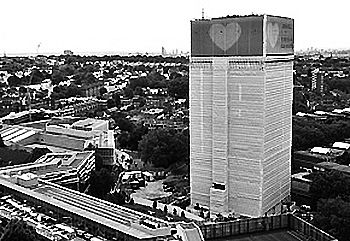How to clean concrete
Contents |
[edit] Introduction
Concrete needs to be cleaned periodically both for reasons of aesthetics and to extend its lifespan. As dirt and grime can build up gradually on concrete surfaces, it is sensible to schedule cleaning at regular intervals. The technique for cleaning concrete depends on the type of surface. Specific stains may require cleaning chemicals, but water is usually sufficient for removing normal dirt.
[edit] External concrete
The most common method for cleaning external concrete (such as for the removal of oil and grease stains) is by using a power washer, which can often be rented. It is usually advisable to spray the surface with a detergent, or alkaline degreaser, and leave for 15-20 minutes before spraying with water. The degreaser has the effect of emulsifying the oil, allowing it to be flushed from the surface using hot water.
Power washers with a pressure rating of at least 3,000 psi and a flow rate of at least 4 gallons per minute should be used. However, difficult contaminants such as paint and heavy tyre-skid marks may require higher pressures. Power washers with a rotary nozzle instead of a standard fan nozzle can increase the cleaning speed. Use of a hand-held lance can direct the spray more accurately.
While it is less expensive and easier to use a cold-water power washer, hot-water units clean faster and more effectively.
Once the power washing is complete, the area should be checked, and any adjacent walls, windows, or other surfaces which have been dirtied should be washed down; usually without the high-pressure function, as normal mains pressure will suffice. Drainage points, gullies or linear channels should be checked for any blockages or silting from wash-off.
Depending on the chemicals used in the power-washing, water runoff may not be allowed to enter storm sewers. In addition, any detritus or dirt that accumulates should be disposed of off-site rather than allowed to wash into sewers.
More difficult stains, such as rust stains which have penetrated deep into the concrete surface, dried grout, or graffiti, may require muriatric acid or oxalic acid, albeit with extreme caution and protective equipment as they are toxic materials.
To tackle graffiti, several proprietary chemical strippers are available, of which, citrus-based solvents are the safest and have the least stringent disposal requirements, although they are the least aggressive and may not work on all types of paint. Products containing potassium hydroxide, which is soaked into the concrete surface for several hours, followed by the application of an acid neutralizer, can also be an effective solution.
[edit] Internal concrete
A less aggressive approach is required for cleaning internal concrete surfaces. It may be sufficient to use a mop and a bucket of water mixed with a mild cleaning product, followed by rinsing with a mop and clean water. Difficult stains can be removed by using trisodium phosphate (TSP) mixed with water and scrubbed onto the area with a brush.
A concrete sealant can be applied every 2 to 3 years to increase a concrete surface’s resistance to stains.
[edit] Related articles on Designing Buildings Wiki
Featured articles and news
The UK's Modern Industrial Strategy: A 10 year plan
Previous consultation criticism, current key elements and general support with some persisting reservations.
Building Safety Regulator reforms
New roles, new staff and a new fast track service pave the way for a single construction regulator.
Architectural Technologist CPDs and Communications
CIAT CPD… and how you can do it!
Cooling centres and cool spaces
Managing extreme heat in cities by directing the public to places for heat stress relief and water sources.
Winter gardens: A brief history and warm variations
Extending the season with glass in different forms and terms.
Restoring Great Yarmouth's Winter Gardens
Transforming one of the least sustainable constructions imaginable.
Construction Skills Mission Board launch sector drive
Newly formed government and industry collaboration set strategy for recruiting an additional 100,000 construction workers a year.
New Architects Code comes into effect in September 2025
ARB Architects Code of Conduct and Practice available with ongoing consultation regarding guidance.
Welsh Skills Body (Medr) launches ambitious plan
The new skills body brings together funding and regulation of tertiary education and research for the devolved nation.
Paul Gandy FCIOB announced as next CIOB President
Former Tilbury Douglas CEO takes helm.
UK Infrastructure: A 10 Year Strategy. In brief with reactions
With the National Infrastructure and Service Transformation Authority (NISTA).
Ebenezer Howard: inventor of the garden city. Book review.
The Grenfell Tower fire, eight years on
A time to pause and reflect as Dubai tower block fire reported just before anniversary.
Airtightness Topic Guide BSRIA TG 27/2025
Explaining the basics of airtightness, what it is, why it's important, when it's required and how it's carried out.
Construction contract awards hit lowest point of 2025
Plummeting for second consecutive month, intensifying concerns for housing and infrastructure goals.
Understanding Mental Health in the Built Environment 2025
Examining the state of mental health in construction, shedding light on levels of stress, anxiety and depression.





















